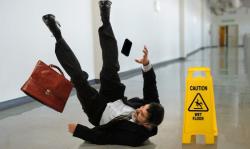 Despite many businesses taking measures to reduce the chances of one of the most common workplace injuries – slip and fall incidents – nearly half of workplace floors fail to meet safety criteria, according to a new study.
Despite many businesses taking measures to reduce the chances of one of the most common workplace injuries – slip and fall incidents – nearly half of workplace floors fail to meet safety criteria, according to a new study.
While well-intentioned employers may take steps to reduce slip and fall injuries by ensuring that walking surfaces don’t have standing water on them or are free of clutter, many overlook flooring selections and ongoing maintenance on slip resistance, the study by CNA Financial Corp. suggests.
When testing workplace floors in a number of industries, the insurance company found that 50% failed to produce “a dynamic coefficient of friction level above the minimum threshold of 0.42” set by the American National Standards Institute, according to a press release.
Researchers with CNA also reviewed slip-and-fall liability claims from its workers’ comp clients’ policies between Jan. 1, 2010, and Dec. 31, 2016, and found that the number of slip and fall incidents was high, while the cost of claims was relatively low, compared to other injuries. This was consistent with claim experiences in the wider risk control industry.
CNA found that the industries with the highest rates of slip and fall incidents among workers were:
• Retail
• Restaurants
• Real estate
Here’s a breakdown of where these slip and fall incidents are occurring:
• Walking and working surfaces (mainly entryway flooring): 40%
• Parking lot surfaces: 33%
• Sidewalks leading to business entrances: 27%
• Interior office floors: less than 1%
What you can do
You should start by evaluating the flooring you have in your various work areas and ensure that the flooring material and design suits the tasks in each workspace. You should also consider what (if any) contaminants, chemicals or other substances workers are using in the area that may increase the risks of slips and falls.
Australia’s Queensland Work Health and Safety Electrical Safety Office recommends that you consider the following when assessing flooring suitability:
• Smooth hard surfaces increase the risk of slips
• Contaminants on the floor further increase the risk
• Improper cleaning can make floors slippery
• Trips can occur when there is a change of half an inch or less in the height of the flooring
• Slips, trips and falls also occur between areas with different types of flooring material
• A floor that is slip resistant when dry may not be slip resistant when wet
• Having a rough surface is more effective than slip-resistant footwear in reducing slips.
When evaluating flooring, look for:
• Flooring that is uneven or in poor condition, including:
– Loose or curling matting
– Torn carpet
– Uneven or broken concrete
– Chipped or cracked tiles.
• Anti-slip paint or tape that is worn, smooth or damaged.
• Areas of slipperiness under normal conditions. Look out for:
– Spots of flooring that are more worn or contaminated than other areas of the same flooring, such as high traffic areas, or in front of a deep fryer.
– Surfaces that may look non-slip but become slippery when wet or otherwise contaminated. Conversely, some surfaces may look slippery or shiny, but are not slippery when contaminated.
• Flooring that may have been originally chosen for a different purpose to how it is being used now, so may no longer be suitable for its current use.
Control measures
When choosing flooring products:
• Consider expected use conditions and expected users
• Consider using materials that grip when both wet and dry
• Select materials for the tasks and typical wear
• Check the cleaning requirements of the flooring
• Ensure floor heights and surfaces are consistent.
